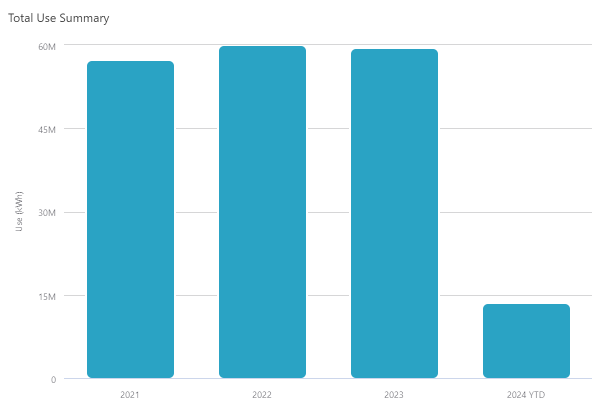Connect With Us...
Carbon Neutrality Action Plan Goals
Decarbonize Purchased Electricity
Summary of high-level actions: 100% Decarbonized purchased electricity either through APS Green Power Partners Program (green locate or green commit) or Virtual Power Purchase Agreement (VPPA) for a 10-15 year period. Additional actions include rehabilitation of the 163 kW south solar field, research and development for microgrid development, storage and peak shaving, demand management, and potential for enhanced behind-the-meter electrical production (biomass backpressure 1MW option).
Kilowatt Usage Over the Past Four Fiscal Years Accordion Open

| Fiscal Year | Use (kWh) |
| 2021 | 57,476,908.83 |
| 2022 | 59,942,775.67 |
| 2023 | 59,602,025.51 |
| 2024 YTD | 13,764,705.61 |
-
Benefits Tab Open
-
Current Action Tab Closed
-
Future Action Tab Closed
-
Student-based investments Tab Closed
Benefits Accordion Open
Benefits: 54% reduction in emissions associated with NAU operations, and a clear demonstration of commitment to decarbonization by 2030.
Current Action Accordion Closed
- The majority of the Flagstaff Mountain Campus’ Scope 1 and 2 greenhouse gas emissions are associated with natural gas combustion for heating (Scope 1) and purchased electricity (Scope 2).
- A review of the economies of scale and access to additional resources off-site enable NAU to purchase renewable power generation produced through geothermal systems, hydro, and tidal systems, nuclear facilities (this fuel is carbon neutral but not renewable), renewable natural gas, biomass, other biofuels, solar PV and solar thermal, and wind.
- Procurement of advisory services to identify a VPPA project, and aggregate with local and regional partners.
To learn more about current renewable energy sources on and off campus, visit this site.
Future Action Accordion Closed
- Determine needed electricity to purchase/over-purchase for RECs
- Outcomes: Determine the needed capacity for renewable energy development
- Benefits: Negotiating the appropriate size for a renewable energy system
- Rehabilitate 163kW South Solar Field
- Outcome: Local production of 270-300K kWhs/yr with value of $21,000/yr
- Research and develop on-site generation, storage, and peak shaving
- Research and develop a microgrid
- Quantification of emission reductions realized by action/investment
Student-based investments Accordion Closed
Undergraduate Symposium Submission, 2021 – Henry Moore CEFNS
Title: Characterization for the Implementation of a Renewable Power-Recovery Groundwater Well in the Deep, Fractured Sandstone Aquifer of Flagstaff, Arizona
Abstract: Energy generation in the state of Arizona is currently based on an outdated, non-renewable system. Northern Arizona has been in a drought since the mid-1990s, creating the need for increased water efficiency within urban and suburban areas, such as Flagstaff, Arizona. Implementation of a power-recovery well can provide solutions to both water and energy supplies in a renewable manner. In the southwest, a common water management strategy to recharge the aquifer is by directing water back down wells. By using this water flow driven by gravity to power a turbine over the depth of these existing wells, electricity could be generated and redistributed throughout the grid for the city of Flagstaff. Calculations have been made in association with existing geotechnical engineering power-recovery standards and theoretical changes possible for a Flagstaff power-recovery well site. The study of power-recovery wells stands to further assist the City of Flagstaff in meeting goals in complying with its Carbon Neutrality Action and Adaptation Plan (2018) through the generation of renewable energy. Characterization of Flagstaff well sites was completed through an analysis of existing geophysical well data compiled for the City of Flagstaff and a literature review of the existing City of Flagstaff pumping wells. Based on the review of this existing information, the best-suited site for a power-recovery well was determined to be in the Switzer Canyon region of the City of Flagstaff.
Undergraduate Symposium Submission, 2021 – Evan Kramer, Noah Bell, Aidan Nash, Benjamin Allen, Nolan McNeil CSE
Title: Collegiate Wind Energy Competition
Abstract: The Department of Energy (DOE) supports an annual Collegiate Wind Energy Competition (CWC) at the American Wind Energy Association (AWEA) CLEANPOWER conference. The problem is as more wind energy is incorporated into the U.S. power generation mix, qualified workers are needed to fill related jobs at all levels. The goal of the CWC is to prepare students from multiple disciplines to enter the wind energy workforce by providing real-world technology experience. The NAU team consists of one electrical and two mechanical engineering sub-teams. These three teams work together to design, build and test an effective mechanical, electrical, and aerodynamic wind turbine and load design that is safe and reliable for testing in an on-site wind tunnel. The electrical team was responsible for all electrical components and enclosures from the turbine to the load. This included a three-phase generator, an AC/DC converter, a DC/DC boost converter to raise the voltage, a microcontroller (MCU) circuit to regulate the output voltage, and a resistive load.